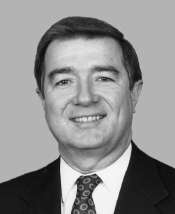Greg Laughlin
| Greg Laughlin | |
|---|---|
 | |
| Member of the U.S. House of Representatives from Texas's 14th district | |
|
In office January 3, 1989 – January 3, 1997 | |
| Preceded by | Mac Sweeney |
| Succeeded by | Ron Paul |
| Personal details | |
| Born |
January 21, 1942 Bay City, Texas |
| Political party |
Democratic (1989-1995) Republican (1995-1997) |
Gregory H. "Greg" Laughlin (born January 21, 1942) is a politician from the state of Texas. He is a former member of the United States House of Representatives.
Life and career
Laughlin was born in Bay City, Texas, and was raised in West Columbia, Texas where he still maintains a residence and he graduated from Texas A&M University. Laughlin served in the United States Army from 1968 to 1970 and later was a reservist. Before election to Congress in 1988, he practiced law in Texas. He served as Assistant District Attorney in Houston, Texas, for four years before returning to private practice.
A conservative Democrat, Laughlin ran for the United States House of Representatives in 1986, narrowly losing to freshman Republican Mac Sweeney, who had served as an aide in the Ronald W. Reagan White House. Laughlin sought a rematch in 1988, and this time he won. Laughlin survived a bitter re-election campaign during the next cycle despite old allegations involving favoritism to a firm.
Laughlin was the only member of Congress to see active duty during Operation Desert Storm in 1991, as a Colonel in the U.S. Army Reserves.
In 1995, the Republican Party, which had gained a majority in the House for the first time in four decades, offered Laughlin a seat on the Ways and Means committee if he joined the GOP. Laughlin did so on June 26, 1995. He claimed that as a Democrat, he had to make some hard votes.
In the subsequent congressional election in 1996, Laughlin was endorsed by many Republican Party leaders, including then-Governor George W. Bush, Speaker of the House Newt Gingrich, and other members of the party from outside the district and the state. Despite this, Laughlin faced a primary challenge from former Texas Republican Congressman Ron Paul, the Libertarian Party presidential candidate in 1988, and Jim Deats, Laughlin's Republican opponent from 1994 (when Laughlin was still a Democrat). In the three-way race, Laughlin won the initial primary election with 42 percent of the vote, but by failing to win a majority he was required to face the second-place Paul in a run-off election. Paul defeated Laughlin by a 56–44 percent margin in the runoff election and went on to win the congressional seat. Paul, who sought the Republican presidential nomination in 2008 and 2012, held the seat until he retired in 2013.
Laughlin remained in Washington, D.C., practicing law at the office of Patton Boggs, in the areas of public policy, energy, international trade, and tax law. He has since moved to the firm of Pillsbury, Winthrop, Shaw, Pittman.
Laughlin is one of the observers that declared the 2004 Presidential elections in Cameroon as being fair. According to the BBC, he stated "we have never seen such a transparent way to show who got the vote".[1]
References
External links
- United States Congress. "Greg Laughlin (id: L000119)". Biographical Directory of the United States Congress.
| United States House of Representatives | ||
|---|---|---|
| Preceded by Mac Sweeney |
Member of the U.S. House of Representatives from Texas's 14th congressional district 1989–1997 |
Succeeded by Ron Paul |